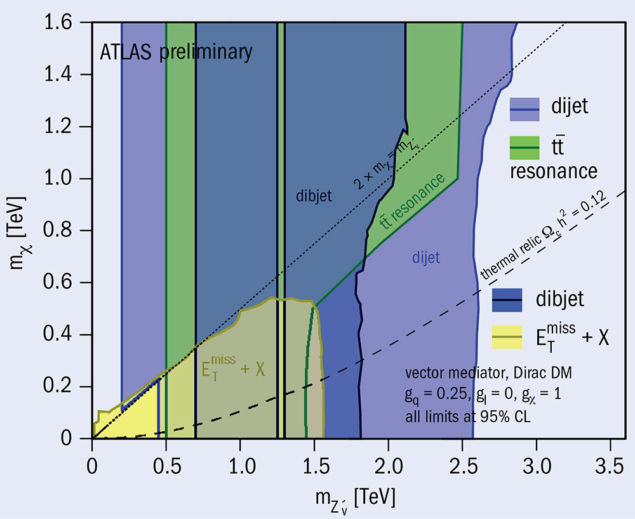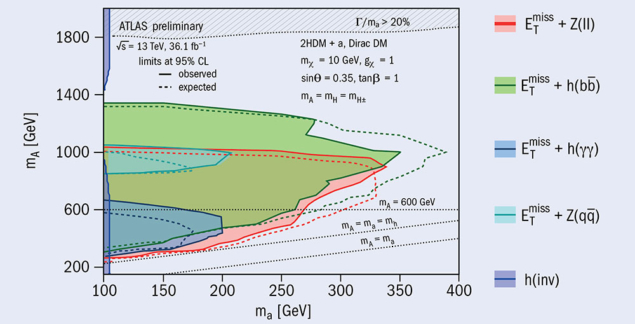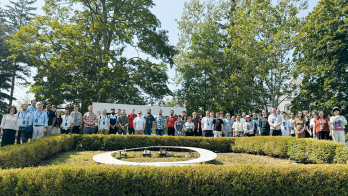
A report from the ATLAS experiment
In our current understanding of the energy content of the universe, there are two major unknowns: the nature of a non-luminous component of matter (dark matter) and the origin of the accelerating expansion of the universe (dark energy). Both are supported by astrophysical and cosmological measurements but their nature remains unknown. This has motivated a myriad of theoretical models, most of which assume dark matter to be a weakly interacting massive particle (WIMP).
WIMPs may be produced in high-energy proton collisions at the LHC, and are therefore intensively searched for by the LHC experiments. Since dark matter is not expected to interact with the detectors, its production leaves a signature of missing transverse momentum (ETmiss). It can be detected if the dark-matter particles recoil against a visible particle X, which could be a quark or gluon, a photon, or a W, Z or Higgs boson. These are commonly known as X + ETmiss signatures. To interpret these searches, a variety of simplified models are used that describe dark-matter production kinematics with a minimal number of free parameters. These models introduce new spin-0 or spin-1 mediator particles that propagate the interaction between the visible and the dark sectors. Because the mediators must couple to Standard Model (SM) particles in order to be produced in the proton–proton collisions, the mediators can also be directly searched for through their decays to jets, top-quark pairs and potentially even leptons. For certain model parameters, these direct searches can be more sensitive than the X + ETmiss ones.
However, simplified models are not full theories like, for example, supersymmetry. Recent theoretical work has therefore focused on developing more complete, renormalisable models of dark matter, such as two-Higgs doublet models (2HDM) with an additional mediator particle. These models introduce a larger number of free parameters, allowing for a richer phenomenology.

Similarly, for dark energy, effective field theory implementations may introduce a stable and non-interacting scalar field that universally couples to matter. This also leads to a characteristic ETmiss signature at the LHC.
ATLAS has recently released a summary gathering the results from more than 20 experimental searches for dark matter and a first collider search for dark energy. The wide range of analyses gives good coverage for the different dark-matter models studied. For new models, such as 2HDM with an additional pseudoscalar mediator, multiple regions of the parameter space are explored to probe the interplay between the masses, mixing angles and vacuum expectation values. For the 2HDM with an additional vector mediator, the resulting exclusion limits are further improved by combining the ETmiss + Higgs analyses where the Higgs boson decays to a pair of photons or b-quarks. For the dark-energy models, two operators at the lowest order effective Lagrangian allow for interactions between SM particles and the new scalar particles. These operators are proportional to the mass or momenta of the SM particles, making them most sensitive to the ETmiss + top–antitop or the ETmiss + jet final states.
To date, no significant excess over the SM backgrounds has been observed in any of the ATLAS searches for dark matter or dark energy. Limits on the simplified models are set on the mediator-versus- dark-matter masses (figure 1), which can also be compared to those obtained by direct detection experiments. For the 2HDM with a pseudoscalar mediator, limits are placed on the heavy pseudoscalar versus the mediator masses, highlighting the complementarity of different channels in different regions of the parameter space (figure 2). Finally, collider limits on the scalar dark energy model (see Colliders join the hunt for dark energy) are also set and for the models studied improve over the limits obtained from astronomical observation and lab measurements by several orders of magnitude. With the full dataset of LHC collisions collected by ATLAS during Run 2, the sensitivity to these models will continue to improve.
Further reading
ATLAS Collaboration ATLAS-CONF-2018-051.
ATLAS Collaboration 2018 ATL-PHYS-PUB 2018-008.








